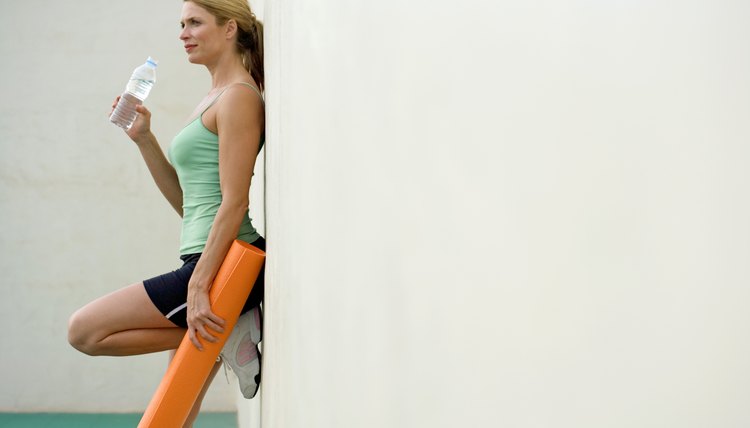Muscles Used to Do a Bridge

The bridge is a bodyweight strength training exercise that develops strength in your core. The exercise is performed by lying on your back with your knees bent and feet on the floor, and then picking up your hips as high as possible. Muscles in the back and hips work together to coordinate the lifting of your hips.
Erector Spinae
The primary mover in the bridge exercise is the erector spinae muscle, which is located along the back of the spine. As you lift your hips up off the floor, your back extends, and the erector spinae muscle is responsible for spinal extension, or straightening of your back. According to ExRx.net, developing strength in the erector spinae muscle effectively reduces pain levels in those who suffer from chronic lower back discomfort.
Gluteus Maximus and Hamstrings
In addition to your back extending, your hip joint straightens as you pick your bottom up off the floor. This joint movement is due to contraction of the gluteus maximus, which is the largest muscle in the buttocks, and the hamstrings. The hamstrings run from the hips down the back of your thighs and consist of three muscles, including the biceps femoris, semimembranosus and semitendinosus.
Isotonic Versus Isometric
The bridge can be performed as an isotonic exercise or an isometric exercise. Isotonic means that your muscles must perform both a concentric contraction, as your muscles shorten while they pick your hips up off the floor, and an eccentric contraction, where your muscles lengthen as they control your hips back down. To perform the exercise isotonically, pick up your hips up off the floor and then immediately lower them back down. Perform the exercise for repetitions.
Isometric means your muscles must hold a contraction over time. To perform the exercise to develop isometric strength, pick up your hips off the floor and hold them up at the top position for as long as you comfortably can. In other words, perform the exercise for duration instead of repetitions.
Difficulty and Isolation
To increase the difficulty of the exercise, perform the bridge with just one foot flat on the floor. Pick up the other foot and hold it inches up off the floor. Drive through the heel of your isolated foot on the floor and pick up your hips as usual. This also places emphasis on one side of the glute and that particular leg’s hamstring.
References
Writer Bio
Kim Nunley has been screenwriting and working as an online health and fitness writer since 2005. She’s had multiple short screenplays produced and her feature scripts have placed at the Austin Film Festival. Prior to writing full-time, she worked as a strength coach, athletic coach and college instructor. She holds a master's degree in kinesiology from California State University, Fullerton.
